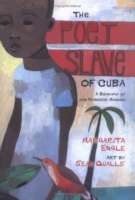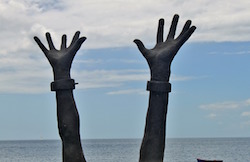by Carmen M. Martínez-Roldán & Amy Olson
The Poet Slave of Cuba: A Biography of Juan Francisco Manzano, by Margarita Engle (2006)
Last week, we started featuring and commenting on literature that represents the experiences of Afro-Latinos and Afro-Caribbean communities highlighting the work of an Afro-Latino author and illustrator, Eric Velasquez. Through the genre of realistic fiction he shares part of his experiences as a native of Spanish Harlem, NY, and as the son of Puerto Rican parents. For the next two weeks we will comment on the work of Cuban American author, Margarita Engle. This week we highlight her young adult novel  The Poet Slave of Cuba: A Biography of Juan Francisco Manzano. In the same way that in his book Grandma’s Gift, Velasquez brings to our attention the life of an enslaved painter named Juan de Pareja, Engle brings to our attention and focuses her whole story on the life of a poet born into slavery in 16th-century Cuba, Juan Francisco Manzano. Engle’s novel had a great impact on the students taking my Latino Children’s and Young Adolescent Literature course and evoked a variety of responses that will be addressed through the next two weeks. This week Amy, a student of applied linguistics, shares her take on Engle’s powerful story.
The Poet Slave of Cuba: A Biography of Juan Francisco Manzano. In the same way that in his book Grandma’s Gift, Velasquez brings to our attention the life of an enslaved painter named Juan de Pareja, Engle brings to our attention and focuses her whole story on the life of a poet born into slavery in 16th-century Cuba, Juan Francisco Manzano. Engle’s novel had a great impact on the students taking my Latino Children’s and Young Adolescent Literature course and evoked a variety of responses that will be addressed through the next two weeks. This week Amy, a student of applied linguistics, shares her take on Engle’s powerful story.
“In this historical fiction piece, Margarita Engle presents Manzano’s biography through the medium of free-verse poetry, composed from the varied, first-person perspectives of the young Manzano, his family members, and his masters. Manzano’s prodigious talent for memorization of text allowed him to self-teach literacy skills in the absence of formal schooling, and in spite of the fact that he was savagely beaten and left for dead each time his mistress discovered him endeavoring to express himself through writing, engraving letters with a fingernail into gardenia leaves. In and of itself, Manzano’s story represents a striking testament to the strength of the human will to persevere in the face of nearly inconceivable odds. However, Engle’s distinctive use of the ever-changing first person narrative voice, delivered in a sparse, free-verse poetic format, underscores the injustice of slavery in a way that surpasses the emotional impact of traditional historical fiction accounts.
In my case, despite having learned about slavery for years in school, The Poet Slave illuminated the atrocities of slavery as well as the inhumane attitude necessary to perpetrate such a cruel system in a novel way. Due to my background in applied linguistics, I began to consider how Engle’s choice to frame the narrative as first-person monologues had inspired this heightened emotional reaction. Numerous authors in the field of discourse analysis acknowledge that authors construct the speech of others to involve readers in the material, allowing the audience to imagine particular worlds, filled with specific details of human activity and interaction. Additionally— as opposed to an explicit, third-person narration— first-person dialogue necessitates that the audience take on the stance of a particular character and recognize that his or her account of events may not be complete, therefore requiring that the reader engage more deeply in critical processes of meaning-making. In the case of Poet Slave, this critical engagement with content is certainly necessary, as story events unfold gradually, with additional layers of meaning added with each character’s recollection of any given phenomenon. Such constructed dialogue, however, is never neutral; indeed, authors animate the voices of others in particular ways in service of their own communicative ends (Tannen, 2007). The following quotes illustrate the manner in which Engle synthesizes linguistic elements to create a distinctive narrative voice for each of the characters. In so doing, she invites the reader to take on diverse stances towards the issue of slavery, ultimately encouraging the reader to condemn the practice as cruel and irrational.
Juan – My mind is a brush made of feathers/ painting pictures of words/ I remember/ all that I see/ every syllable/ each word a twin of itself/ telling two stories/ at the same time/ one of sorrow/ the other of hope. (p. 1)
Free verse poetry seems to be an ideal medium through which to animate Juan’s inner monologues: in Juan’s passages, literal narration is interspersed with metaphorical accounts of his flowering inner, intellectual world. The above quote typifies the imagery characteristic of Juan’s narration, and one marvels at the fact that he is able to harbor such idealistic thoughts in spite of the hardships he suffers as a slave. Indeed, this particular quote exemplifies the harsh contrast between Juan’s inner and outer experiences.
Juan – I sit tied and gagged./ She is there, behind the curtain./ The tight cloth choking my mouth keeps me safe./ She can’t hear the stories I tell myself in secret./ In silence./ Hidden./ I talk to the tables and walls./ I talk to the people and fruit trees/ and horses and fish/ in the paintings. (p. 54)
Similar to the previous quote, this passage exemplifies Juan’s use of creative storytelling to resist oppression, actively leveraging his creative inner world to shield himself from the atrocities in his physical world. Quotes, such as this one recur throughout the book, illustrating the torment slaves experienced upon being denied access to formal education, as well as outlets for creative self-expression. Although many historical textbooks likely cite this information as an unfortunate practice of this historical period, the first-person perspective through which Engle expresses it allows the reader to directly confront this reality of slavery, and more concretely envision its implications.
La Marquesa de Prado Ameno – Some people can never be satisfied./ The poet-boy for instance./ Nothing is ever enough for him./ I have to tell the overseers to teach/ the same lessons/ over and over/ locking his ankles in the stocks/ tying him to a cross like Jesus. (p. 56)
Unlike Juan’s narratives, which evoke empathy and awe, the first-person accounts of the Marquesa invite criticism from the reader for her sadistic treatment of her subordinates, and the nonchalant logic with which she frames these actions as natural, just responses to behavioral infractions. The Marquesa’s calmly condescending account of such an incident— in which Juan was shackled to a cross and beaten— offers the reader a firsthand view into the corrupt logic of a cruel slave owner, thereby underscoring the utterly inhumane moral foundation upon which slavery developed.
The Overseer – I grab the rope,/ I yank it to save him/ proud of my compassion/ and at the same time furious with him/ for dislocating his arm/ at the end of my rope. (p. 119)
The overseer’s quote illuminates the corrupt manner in which individuals justified their involvement with the slave industry. However, since the overseer physically enforces the cruel punishments, rather than simply issuing them, his rationalizations are yet more absurd than those of the Marquesa. In the above quote, for instance, he expresses pride in his own compassion upon having brought an end to a vicious dog attack, which he himself had facilitated in the first place. Yet more absurd is his subsequent frustration with Juan for dislocating his arm in the process.”
While the topic of slavery is often presented in history books as an almost forgotten part of our history with little relevance to contemporary life, Engle’s powerful writing pulls the reader into the story in such a way that the reader can no longer feel distant. Moreover, in her novel Silver People: Voices from the Panama Canal, which we will introduce later this month, Engle gives continuity to the consequences of slavery and new forms of slavery. Her work invites the young reader to develop not only empathy but agency, a call to create a more just world.
References
Engle, M. (2006). The Poet Slave of Cuba: A Biography of Juan Francisco Manzano. New York, N.Y.: Henry Holt & Company.
Tannen, D. (2007). Talking Voices: Repetition, Dialogue, and Imagery in Conversational Discourse. New York, N.Y.: Cambridge House University Press.
Journey through Worlds of Words during our open reading hours: Monday-Friday, 9 a.m. to 5 p.m. and Saturday, 9 a.m. to 1 p.m. To view our complete offerings of WOW Currents, please visit archival stream.


This that any text involving Juan Francisco Manzano is a great text for various reasons. We tend to associate African slavery solely with the United States and I think that limits our understanding of the bigger complexities of the Americas. Although the term Latino is a U.S based term we shouldn’t homogenize the complexity of the Americas. Dichotomizing Latino from Black is a recurrent limited categorization that I find troubling in the United States and Latin America. Latino is too often associated with people being “mixed” which then becomes problematic when addressing issues of racism, socio-economic equity and the sexualizing of Black women. Margarita Engle definitely hits the nail on the head by mentioning such a figure as Manzano. Unlike Manzano who was a house slave, Esteban Montejo was an Afro-Cuban field slave and a soldier during the Spanish-Cuban war. Comparing these two figures would increase our understanding of Black life in the Spanish speaking Caribbean. I would like to see Montejo’s story become accesible and adapted to young people in the near future. I think we have a new wave of writers re-claiming different dimensions of Latinidad. We need more stories like these.